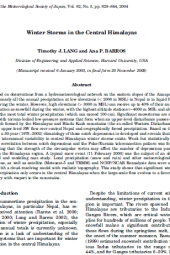Winter Storms in the Central Himalayas
Summary
This journal article published in the Journal of the Meteorological Society of Japan talks about the existence of interannual variability in central Himalayan winter storms. This study shows that significant wintertime precipitation only occurs in the central Himalayas when the large-scale flow evolves to a favorable geometry concerning the mountains.
Observations from a hydrometeorological network on the eastern slopes of the Annapurna Range in Nepal indicate that at low elevations (< 2000 m MSL), almost all annual precipitation occurs in liquid form, even in winter. In contrast, high elevations (> 3000 m MSL) can experience up to 40% of their winter precipitation as snowfall, with the highest altitude stations receiving over 100 cm. Terrain-locked low-pressure systems associated with Western Disturbances passing over the Himalayas notch contribute to significant snowstorms at higher elevations. A 30-year climatology (1973–2002) highlights interannual variability in winter storms, with a weak but statistically significant correlation between these storms and the Polar/Eurasia teleconnection pattern. A case study of a typical snow event in February 2000 reveals that substantial wintertime precipitation occurs in the central Himalayas when the large-scale atmospheric flow aligns favorably with the region's topography.
Categories:
Article
Publisher:
Journal of the Meteorological Society of Japan
Published Year:
2004
